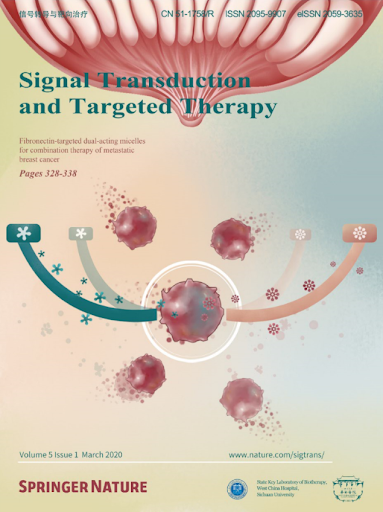Efficacy, safety and exploratory analysis of neoadjuvant tislelizumab (a PD-1 inhibitor) plus nab-paclitaxel followed by epirubicin/cyclophosphamide for triple-negative breast cancer: a phase 2 TREND trial.
IF 40.8
1区 医学
Q1 BIOCHEMISTRY & MOLECULAR BIOLOGY
引用次数: 0
Abstract
The optimal chemotherapy backbone and specific population of triple-negative breast cancer (TNBC) patients that benefit from neoadjuvant immunotherapy are not well established. This prospective, single-arm, phase II TREND trial assessed the efficacy and safety of tislelizumab plus nab-paclitaxel and epirubicin/cyclophosphamide-based chemotherapy as a neoadjuvant treatment for TNBC (ChiCTR2000035262). The primary endpoint was pathological complete response (pCR), with the secondary endpoints including safety assessment and objective response rate (ORR). ScRNA-seq, bulk RNA-seq, TCR-seq, cyTOF and WES were performed on pre-treatment and post-treatment samples. Among 53 total enrolled patients, 44 completed the combined neoadjuvant therapy, and 30 of 44 patients (68.18%) achieved pCR. Additionally, 14 out of 44 patients had a complete response (31.82%), with an ORR of 93.18%. The most commonly observed treatment-related adverse events (TRAEs) were alopecia, nausea and liver injury with 6 cases classified as grade 3 or higher adverse events. Immune response-related pathways, including TNF signaling pathway, T cell receptor signaling pathway, were enriched in pCR group. Pre-treatment model was identified and construct to predict response to immunotherapy. CDKN1A+ CD8 T lymphocytes were enriched in pCR group after neoadjuvant immunotherapy. Dynamic change of immune-related pathways at an early stage during the neoadjuvant immunotherapy may be associated with the treatment efficacy. In conclusion, neoadjuvant treatment of tislelizumab with nab-paclitaxel and anthracycline-based chemotherapy showed promising clinical activity and was well-tolerated among TNBC patients, without high incidence of TRAEs. These findings provide evidence supporting neoadjuvant tislelizumab with chemotherapy as an effective rational approach for treating TNBC.新辅助tislelizumab(一种PD-1抑制剂)联合nab-紫杉醇联合表柔比星/环磷酰胺治疗三阴性乳腺癌的疗效、安全性和探索性分析:一项2期TREND试验。
从新辅助免疫治疗中获益的三阴性乳腺癌(TNBC)患者的最佳化疗骨干和特定人群尚未得到很好的确定。这项前瞻性单组II期TREND试验评估了tislelizumab联合nab-紫杉醇和表柔比星/环磷酰胺化疗作为TNBC新辅助治疗的有效性和安全性(ChiCTR2000035262)。主要终点是病理完全缓解(pCR),次要终点包括安全性评估和客观缓解率(ORR)。对处理前后样品进行ScRNA-seq、bulk RNA-seq、TCR-seq、cyTOF和WES检测。在53例入组患者中,44例完成了联合新辅助治疗,其中30例(68.18%)达到pCR。此外,44例患者中有14例完全缓解(31.82%),ORR为93.18%。最常见的治疗相关不良事件(TRAEs)为脱发、恶心和肝损伤,其中6例为3级或以上不良事件。pCR组免疫应答相关通路,包括TNF信号通路、T细胞受体信号通路富集。确定并构建治疗前模型以预测免疫治疗的反应。新辅助免疫治疗后,pCR组CDKN1A+ CD8 T淋巴细胞富集。新辅助免疫治疗早期免疫相关通路的动态变化可能与治疗效果有关。综上所述,新辅助治疗tislelizumab联合nab-紫杉醇和蒽环类化疗显示出良好的临床活性,并且在TNBC患者中耐受性良好,没有高发生率的trae。这些发现为新辅助tislelizumab联合化疗作为治疗TNBC有效合理的方法提供了证据。
本文章由计算机程序翻译,如有差异,请以英文原文为准。
求助全文
约1分钟内获得全文
求助全文
来源期刊

Signal Transduction and Targeted Therapy
Biochemistry, Genetics and Molecular Biology-Genetics
CiteScore
44.50
自引率
1.50%
发文量
384
审稿时长
5 weeks
期刊介绍:
Signal Transduction and Targeted Therapy is an open access journal that focuses on timely publication of cutting-edge discoveries and advancements in basic science and clinical research related to signal transduction and targeted therapy.
Scope: The journal covers research on major human diseases, including, but not limited to:
Cancer,Cardiovascular diseases,Autoimmune diseases,Nervous system diseases.
 求助内容:
求助内容: 应助结果提醒方式:
应助结果提醒方式:


